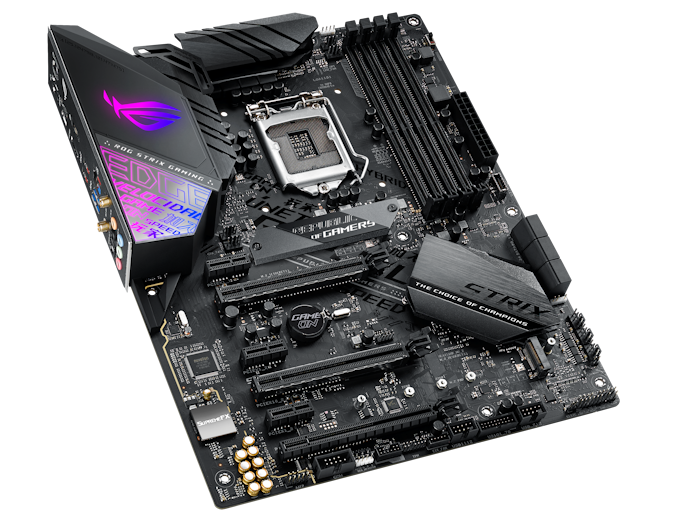Intel Z390 Motherboard Overview: 50+ Motherboards Analyzed
by Ian Cutress & Gavin Bonshor on October 8, 2018 10:53 AM EST- Posted in
- Motherboards
- Intel
- MSI
- Gigabyte
- ASRock
- EVGA
- Asus
- NZXT
- Supermicro
- Z390
The ASUS ROG Strix range of motherboards slot right in between the Maximus XI and TUF Gaming ranges but with a mixture of features and traits from both ranges to keep pricing competitive with other vendors mid-range offerings. These affordable models do have a good range of overclocking, but without the extreme components and more importantly, without the larger price tags associated with the higher echelon of Maximus XI models.
ASUS ROG Strix Z390-E Gaming
The ASUS ROG Strix Z390-E is another Z370 model to get an overhaul of sorts ready for the new 9th generation Intel processors. The newer Strix Z390-E looks relatively similar in terms of PCB space. The main differences come visually with the new Z390-E having primarily black themed heatsinks with a customizable RGB ROG logo with ROG Edge holographic branding towards the bottom of the rear panel cover. The chipset heatsink features the Strix branding and has a metallic grey and black monotone design.
Across the center of the board are three full-length PCIe 3.0 slots which run at x16, x8 and x4 which means two-way SLI and up to three-way CrossFire multi-graphics card configurations are supported. The Z390-E also has three PCIe 3.0 x1 slots which give users one less than the previous Z370-E. Storage wise the Z390-E has two M.2 slots with one dedicated to just PCIe 3.0 x4 drives and the second allowing for both PCIe 3.0 x4 and SATA drives to be used; both M.2 slots have inclusive heatsinks. The board also has a total of six SATA ports with support for RAID 0, 1, 5 and 10 arrays. There are four RAM slots with official support for up to DDR4-4266 with a total capacity of up to 64 GB.
On the rear panel of the mid-ranged Strix Z390-E Gaming is a varied selection of input and outputs. USB support consists of three USB 3.1 Gen2 Type-A, one USB 3.1 Gen2 Type-C, two USB 3.0 Type-A and two USB 2.0 ports. A pair of video outputs consisting of a DisplayPort and HDMI are featured, along with a PS/2 combo port, an Intel I219V Gigabit controlled LAN port and connectors for the 2T2R 802.11ac Intel 9560 Wi-Fi adapter. Finishing off the rear panel is five 3.5 mm audio jacks and a single S/PDIF optical output powered by the ROG SupremeFX S1220A HD audio codec.
The ASUS ROG Strix Z390-E Gaming pricing is unknown at present and represents the most feature-rich of the Strix branded gaming motherboards. The main difference between the Z390-E Gaming and the other ATX sized Z390 Strix based models are the inclusion of the 1.73 Gbps capable Wi-Fi adapter with Bluetooth 5 connectivity support; this is one of the main reasons for the increase in price too.












79 Comments
View All Comments
DanTMWTMP - Thursday, October 11, 2018 - link
Are they ALL made in China? What happened to the ones made in Taiwan from a few gens ago? :/gavbon - Friday, October 12, 2018 - link
Unfortunately, I cannot confirm this. The ASRock Z390 Taichi I have in my hands says 'designed in Taipei', but that's about it.Nagorak - Sunday, October 14, 2018 - link
Gigabyte apparently has a factory in Taiwan. It seems all the rest moved production to China.WickedMONK3Y - Friday, October 12, 2018 - link
The MEG Z390 Godlike looked like such an interesting board until I checked the MSI Specifications page and realised it actually does not have the PLX chip as suspected. The PCI Express slots on the board are configured as 16x / 4x / 8x / 4x instead of 16x / 16x / 8x / 4x or 16x / 8x / 16x / 4x. It seems after PLX sold to whomever owns them now, that the price hike stopped their usage on consumer boards completely.I really really hope somebody comes out with a board that has a PLX chip on board.
gavbon - Friday, October 12, 2018 - link
The Supermicro C9Z390-PGW has a Broadcom 8747 PLX PCIe switch :)ZioTom - Friday, October 12, 2018 - link
It would be a nice touch including in next MB review what pheriferals stop funcioning when too much PCI-E lanes are used. Some motherboards disable SATA ports when M.2 slot are used; others may require limiting bandwith to one PCI-E slot... etc. Before byuing a motherboard I would like to be warned that is not possibile to use all the features they are advertising.happyfirst - Friday, October 12, 2018 - link
I wish we would get better thunderbolt support. Only one board has it built in? I'm thinking of a Taichi board and see a Thunberbolt AIC connector in the manual, but then I can't really find enough good quality posts of people having success putting it to use. I'd like to get a new external nvme ssd thunderbolt drive to run my vms off of so I can more easily take them on the road with me and use from my notebook.ddcc - Saturday, October 13, 2018 - link
Certain Gigabyte boards, e.g. Z390 Aorus Pro WiFi, seem to be using Intel's Z390 CNVi, but aren't listed in the article.gavbon - Monday, October 15, 2018 - link
I'm going to be updating tomorrow with more information; been working on getting one of the board reviews ready for the end of the week :)gavbon - Sunday, October 21, 2018 - link
Will be adding these in tomorrow (not at a PC currently) - We didn't have the information available prior to writing